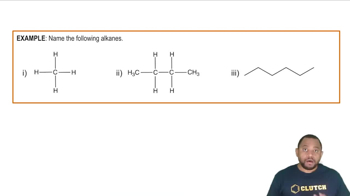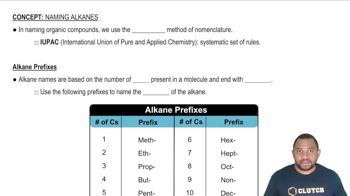Here are the essential concepts you must grasp in order to answer the question correctly.
Alkane Structure
Alkanes are hydrocarbons that consist solely of carbon (C) and hydrogen (H) atoms, connected by single bonds. Their general formula is CnH2n+2, where 'n' is the number of carbon atoms. The structure of alkanes can be represented in various forms, including condensed structural formulas and skeletal structures, which illustrate the connectivity of atoms.
Recommended video:
Isomerism in Alkanes
Isomerism occurs when compounds have the same molecular formula but different structural arrangements. In alkanes, this can lead to different physical and chemical properties. For example, 2,2-dimethylpentane and 3-isopropylheptane are structural isomers, meaning they have the same number of carbon and hydrogen atoms but differ in how these atoms are arranged.
Recommended video:
Naming Alkanes (IUPAC Nomenclature)
The International Union of Pure and Applied Chemistry (IUPAC) provides a systematic way to name organic compounds, including alkanes. The name reflects the longest carbon chain and the position of any substituents. For instance, in 4,4-diethyloctane, 'octane' indicates an eight-carbon chain, while '4,4-diethyl' specifies that two ethyl groups are attached to the fourth carbon of the chain.
Recommended video:
 Verified step by step guidance
Verified step by step guidance


